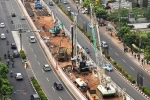Railway performance: KAI's confident steps towards transformation
This article has been translated by PwC Indonesia as part of our Indonesia Infrastructure News Service. PwC Indonesia has not checked the accuracy of, and accepts no responsibility for the content.
Bisnis Indonesia - Kinerja perkeretaapian: Langkah pasti transformasi KAI
27 September 2023
Three years ago, PT KAI (Persero) President Director Didiek Hartantyo believed that the company that he leads would not sink due to the Covid-19 pandemic. Didik continued to brainstorm so that the Indonesian railway operator company could survive under the immense pressure.
The company that relies on passenger mobilisation had to survive the prohibition of people mobilising amid the pandemic. Never giving up, Didiek made a breakthrough with several strategies that are starting to produce results.
In August 2023, Didiek started to smile widely. In exactly one month before the company that he leads turned 78, the company recovered after fighting for three years. KAI has now been completely reborn with a new innovation spirit that is different from the previous one.
“So, why is our recovery so quick? Because our pandemic-handling strategies are suitable,” Didiek said to Bisnis recently.
According to Didiek, there are 4 things that were implemented by the company to transform. First, since the start of the pandemic, the company has always protected the people. It means, even though the company’s revenue was rapidly declining, KAI still prioritised the safety of its passengers and employees.
Then, building liquidity. The solution is to reschedule obligations that can be negotiated, such as loan and tax payments, to create liquidity.
“Protect the people first, then liquidity. So, imagine us rescheduling our obligations,” he explained.
Next, efficiency. At the time, his company could excellently manage their cashflow, so railway operation was not hindered during the pandemic.
“Alhamdulillah (Praise be to God), we also received the PEN (National Economic Recovery) [fund] at the end of 2020 worth Rp3.5 trillion. So, with the PEN [fund], we maintained our liquidity to be better.”
The last strategy is to make an inventory of new revenue sources so that the company can accelerate its performance during and after the pandemic.
“We saw that what was affected by the pandemic was the people as the movement of passengers significantly declined due to health protocols. KAI basically has two main revenue sources, namely passenger transportation and freight transportation. Meanwhile, we are still trying to make asset revenue the third pillar,” he added.
The steps were proven to be effective as they have significantly improved the company’s performance. Moreover, he logged that the company’s revenue in 2022 surpassed its revenue in 2019 when the pandemic has not hit Indonesia.
“We recovered quickly with excellent pandemic handling. KAI’s revenue has beaten its revenue in 2019 before the pandemic. Our revenue in 2022 reached Rp22.9 trillion. Meanwhile, our revenue in 2019 reached Rp22.5 trillion,” he explained.
The company’s profit also showed a positive trend in 2022. At the time, KAI logged a profit of Rp1,686 trillion after it struggled in 2020 with loss reaching Rp1.7 trillion.
Meanwhile, until the first half of 2023, the company’s performance continued to improve to realise a revenue of Rp12,558 trillion. In detail, Rp4,24 trillion came from the passenger sector and Rp5.3 trillion from freight transportation. The rest came from other revenue sources.
“Looking at the current development, we are optimistic about achieving our revenue target in 2023. Passenger transportation is near the 2023 target that reaches Rp9.4 trillion. Meanwhile, our freight transportation target in 2023 is around Rp12 trillion,” he revealed.
Didiek admits that he is still passionate about bringing KAI to its top performance. There is something that inspired him during the pandemic that is currently the main focus, which is the optimisation of KAI’s assets.
Didiek said that assets were the third pillar of KAI’s revenue after passenger and freight transportation. According to him, the number and the value of KAI’s assets must be a variable in the company’s revenue.
One of the efforts that is currently implemented by the company is boosting the certification of assets that are owned progressively. It is carried out to accelerate asset monetisation that were previously not optimal.
Another effort is to market potential assets proactively. This solution is implemented by the company to obtain potential tenants for assets that are in the form of houses or lands so that they can be new revenue sources.
“We are also implementing proactive marketing solutions where we market our assets so that they can be used by tenants. The assets can be in the form of stations, lands, or houses that KAI own, so the assets can be developed,” he added.
Moreover, his company is also accelerating collaborations with investors to develop the naming rights system, which is similar to what is implemented at Semarang Tawang Bank Jateng Station.
“Besides service areas, we are also developing commercial areas so that station construction can be financed by investors that are provided a certain management rights period. So, revenue from the commercial area will be their right to return their investment. In the future, we will develop the naming rights of stations. Such as Semarang Tawang where we are cooperating with Bank Jateng. We are developing it,” he explained.
Transformation momentum
For Didiek, the commemoration of the National Railway Day in Indonesia that is also PT KAI’s 78th anniversary is a transformation momentum for the railway sector in Indonesia.
The momentum coincides with the operation of Jakarta-Bandung High-speed Railway (KCJB) that is named Whoosh. Besides that, Jabodebek LRT is also a milestone in Indonesia’s railway sector that has become more advanced.
Hence, he is encouraging the government to focus more on effective, efficient, affordable, and eco-friendly mass transportation development so that railways can be available all over the country.
“I hope that the government will develop more rail-based mass transportation as they build efficient passenger and freight transportation ecosystems. So, the choice is railways. There is no modern country without an advanced railway,” he explained.
The statement is a follow up to President Joko Widodo’s order to welcome Golden Indonesia in 2045. So, in the future, railways will be the solution for the environmental issues that the government are currently focusing on.
“Jokowi said that the cost of traffic jams reaches Rp100 trillion per year. If we can optimise it, we can use it for other productive matters. In the future, the government is expected to allocate a sufficient budget for railway development in Indonesia. So, railways can reach all parts of the country. The development of the infrastructure requires a large cost, but its impact will be long lasting as it will provide transportation for the people of Indonesia,” he stated.


















